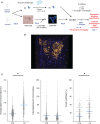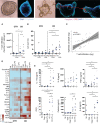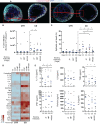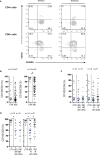Autologous organoid co-culture model reveals T cell-driven epithelial cell death in Crohn's Disease
- PMID: 36439157
- PMCID: PMC9685428
- DOI: 10.3389/fimmu.2022.1008456
Autologous organoid co-culture model reveals T cell-driven epithelial cell death in Crohn's Disease
Abstract
Lympho-epithelial interactions between intestinal T resident memory cells (Trm) and the epithelium have been associated with inflammatory bowel disease (IBD) activity. We developed ex vivo autologous organoid-mucosal T cell cocultures to functionally assess lymphoepithelial interactions in Crohn's Disease (CD) patients compared to controls. We demonstrate the direct epithelial cell death induced by autologous mucosal T cells in CD patients but not in controls. These findings were positively correlated with T cell infiltration of the organoids. This potential was inhibited by limiting lympho-epithelial interactions through CD103 and NKG2D blocking antibodies. These data directly demonstrate for the first time the direct deleterious effect of mucosal T cells on the epithelium of CD patients. Such ex-vivo models are promising techniques to unravel the pathophysiology of these diseases and the potential mode of action of current and future therapies.
Keywords: CD103; NKG2D; crohn’s disease; inflammatory bowel diseases; lymphoepithelial interactions; organoids.
Copyright © 2022 Hammoudi, Hamoudi, Bonnereau, Bottois, Pérez, Bezault, Hassid, Chardiny, Grand, Gergaud, Bonnet, Chedouba, Tran Minh, Gornet, Baudry, Corte, Maggiori, Toubert, McBride, Brochier, Neighbors, Le Bourhis and Allez.
Conflict of interest statement
MA received grant supports from Innate Pharma, Janssen, Takeda, Genentech/Roche, and honoraria for teaching activities or consultancy from Abbvie, Amgen, Biogen, Boehringer-Ingelheim, Bristol Myers Squibb, Celgene, Celltrion, Ferring, Genentech, Gilead, IQVIA, Janssen, Novartis, Pfizer, Roche, Takeda, Tillots. NH received honorarium for consultancy from Janssen and Takeda. M-LT-M received honoraria from Abbvie and Janssen. J-MG has been a speaker and/advisory board member for Abbvie, Amgen, Celltrion, Takeda, Janssen and Sanofi Genzyme. SH, JB, HB, KP, LC, MB, VC, BG, CG, DH, JB, HC, LM, CB, AT and LLB have no conflict of interest to declare. MN, JM are employed by Genentech and CB by Institut Roche. The remaining authors declare that the research was conducted in the absence of any commercial or financial relationships that could be constructed as a potential conflict of interest.
Figures






References
Publication types
MeSH terms
LinkOut - more resources
Full Text Sources
Medical
Research Materials

